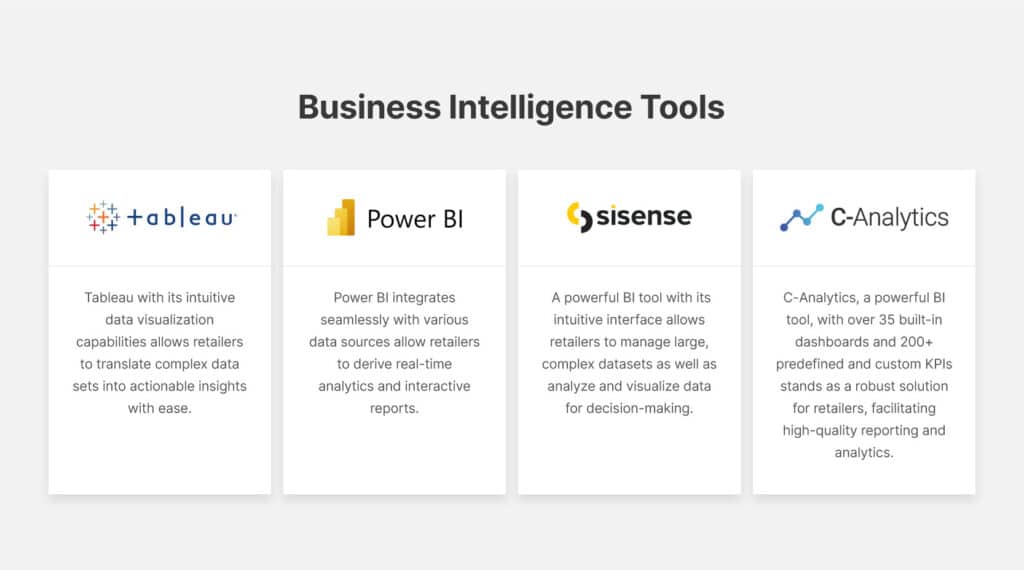
Global Content Lead - Tech & Consulting
Subscribe to the newsletter
There’s no denying that in the retail sphere, any retailer’s most important assets are its data and people. The sheer volume of data available to retailers serves as both a blessing and a challenge, demanding innovative approaches to extract meaningful insights.
Recognizing this prevailing concern, a significant transformation is unfolding as companies transition from traditional reporting methods in favor of modern data platforms. In fact, it wouldn’t be an overstatement to say that the most successful retailers are those who invest in AI and Big Data analytics. This strategic shift enables them to translate vast datasets into actionable insights, facilitating fact-based decisions for enhanced efficiency and a competitive edge.
The growing global AI retail market, projected to reach 31.18 billion U.S. dollars by 2028, stands as a testament to this evolution. This transition not only addresses the need for real-time, actionable insights but also signifies a strategic leap to keep pace with the competitors in an era where the convergence of data and AI is reshaping retail operations.
In this blog, we will explore the empowering impact and the use of AI in data analytics on retailer’s reporting and decision-making capabilities.
A closer look at the traditional reporting challenges in retail
In retail, every organization relies heavily on reporting to furnish both real-time and historical data, which is essential for monitoring company performance. Internally, various departments generate their own reports. This inundation of data – be it – structured, unstructured, or semi-structured – possesses several challenges that impede its ability to leverage data effectively.
To address these challenges, companies turn to reporting tools, leverage automation for data collection and report generation, and convert raw data into actionable insights. However, when digging into data in search of insights, some of the most common challenges that add a layer of complexity to carry out seamless analysis include:
- Poor data hygiene: Inconsistent or inaccurate data hampering the analysis process.
- Slow reporting processes: Delays in reporting impeding timely decision-making.
- Basic tabular and static reporting: Limited formats with short lifespans.
- Lack of visual dashboards: This is especially noticeable in executive reporting.
- Data aggregation hassles: Gathering data from multiple sources
- Inconsistency across reports: Discrepancies in data across different reports.
- Data security gaps: Concerns over the protection of sensitive information.
- Manual and lengthy reporting: Time-consuming processes, hindering efficiency.
- Lack of integrated reporting: Absence of a cohesive reporting framework.
- Insufficient actionable insights: Reports lacking practical, actionable information.
These challenges highlight the urgent need for a transformative approach to data management within the retail sector.
Now, what is the path forward for retailers?
Owing to the limitations of traditional reporting, retailers are now embracing business intelligence tools to propel themselves toward strategic decision-making. Consider notable solutions, such as Tableau, Power BI, Oracle, and C-Analytics – the big names. As retailers continue to generate massive volumes of data from various channels such as e-commerce, in-store purchases, social media, and mobile apps, having an effective retail data analytics solution becomes essential for driving growth and staying competitive.
These solutions are not just sorting the challenges posed by traditional reporting but are also allowing retailers to shape their operations proactively to expect maximum efficiency. Additionally, they are allowing companies to adopt swift reporting, stay up-to-date with the performance, and make decisions with data-driven insights.

McKinsey & Company states that retailers leveraging data analytics and operational reporting are 23 times more likely to attract new customers and up to 6 times more likely to retain their existing customer base.
This means that retailers who actively employ big data analytics platform and operational reporting tools have a significantly higher likelihood of gaining new customers and retaining existing ones – the ultimate goal of retailers.
Further reading: Future-proof your retail business by embracing data analytics & AI.
How AI in data analytics is a game-changer for retailers?
As retailers are on the path of modernization. AI implementation in data analytics has transformed the way they use and interpret data to gain deeper insights at their disposal. Data analytics in the retail industry offers meaningful and actionable insights to retailers for informed decision-making. From tracking customer preferences to predicting market trends, the value of leveraging big data cannot be overstated. With advanced data analytics retail platforms, businesses are going beyond traditional reporting to embrace real-time analytics and machine learning algorithms that provide deeper insights.
However, when it comes to reporting, the benefits of AI in data analytics for retail go beyond. What traditional reporting methods have the potential to achieve? These include:
- AI algorithms analyze historical data to identify patterns allowing retailers to use this capability to forecast future sales, demand, and trends with higher accuracy.
- AI automates the reporting process by streamlining data collection, analysis, and generation of reports, reducing the manual effort required for routine reporting.
- AI-powered retail data analytics provide real-time insights into customer preferences and market changes. And allow retailers to make informed decisions on the go.
Giant retailer, Walmart uses AI-driven data analytics to monitor sales performance and identify trends in customer behavior to enhance customer experience. Tesla uses AI for data analytics and is concurrently developing a versatile autonomous humanoid robot capable of performing an array of tasks. Similarly, streaming platform Netflix uses AI-powered analytics to track viewers’ watching habits and preferences, allowing it to recommend relevant content as soon as a user logs in.
Given AI’s significant impact on data analytics, IDC researchers predicted that by 2028, 50% of retailers will offer AI-enabled contextualized recommendations to enhance customer engagement, increasing real-time interactions by 30% and overall conversion rates by 20%.
Microsoft Fabric: Empowering retail transformation through AI-powered data analytics
Microsoft Fabric has emerged as a game changer for retailers seeking a powerful and comprehensive data analytics solution capable of managing large and complex data. This all-in-one data analytics platform covers everything from data movement to data science, real-time analytics, and business intelligence.
Microsoft Fabric presents an integrated suite of services, housing Data Lake, data engineering, and data integration – all consolidated in a unified data analytics platform. Power BI, which is also a part of the Microsoft Fabric ecosystem, offers data analysts a convenient gateway to diverse data sources. This integration, coupled with the collaborative capabilities of Power BI and Copilot, empowers analysts to access data and create tailored reports effortlessly.
Microsoft Fabric is helping with various analytics for retail, some of which include:
Customer analytics
Retailers use Microsoft Fabric to understand their customers, predict their preferences, and recommend products that suit their requirements. Moreover, it also helps them measure customer satisfaction and recognize areas that need improvement.
Operational analytics
Microsoft Fabric empowers retailers to enhance operational efficiency through insights into inventory, supply chain, logistics, and store performance. Moreover, it also helps detect and prevent fraud and theft.
Marketing analytics
Microsoft Fabric helps retailers create effective marketing campaigns by analyzing data from various mediums, such as social media, web, and mobile. It also helps retailers track and examine their customer journey.
Competitive analytics
Microsoft Fabric allows retailers to outperform by analyzing data from competitors, market trends, and industry benchmarks. It allows retailers to assess their performance, identify opportunities, and adapt to changing customer demands.
Hence, Fabric’s AI in data analytics has provided a unified platform for retailers to make effective decisions based on data analytics in today’s competitive market.
Read more: Copilot in Microsoft Fabric: AI-driven data experience.
The role of AI in improving the data analytics workflow: A step-by-step process
We all recognize the power of AI for data analytics. But only some know its potential to streamline analysis and generate actionable insights. Let’s take you through the step-by-step approach of AI’s potential in transforming the data analytics workflow.
Data preparation
In the initial stage of data analytics, AI significantly streamlines data preparation. Automated cleaning algorithms identify and rectify errors and missing values. While integration capabilities ensure a seamless combination of diverse data sources.
Additionally, AI in data analytics plays a crucial role in normalizing and standardizing data to promote consistency for accurate analysis.
Data exploration
Moving on to data exploration, AI’s contribution becomes even more pronounced. Advanced algorithms excel at recognizing intricate patterns, trends, and anomalies within vast datasets to provide valuable insights during the exploratory data analysis (EDA) phase.
AI further aids in feature engineering by automating the generation and testing of new features. Thereby enhancing the dataset’s richness and improving the models’ predictive capabilities.
Data modeling
As the data analytics workflow progresses to modeling, AI continues to play a pivotal role. It assists in model selection by evaluating the data’s characteristics and determining the most appropriate modeling technique.
AI’s automated hyperparameter tuning optimizes model parameters, enhancing accuracy and generalizability. Furthermore, AI combines predictions from multiple models, resulting in more robust and accurate outcomes.
Data security
Data security is paramount, and AI contributes significantly to this aspect. Its ability to detect anomalies is leveraged for identifying unusual patterns or behaviors that may signal security threats.
AI-driven access control systems regulate user permissions and enhance data security, and encryption algorithms contribute to safeguarding sensitive information.
Data reporting
Finally, AI continues to improve the data analytics workflow in the reporting phase. The automation of report generation is a key highlight that saves time and reduces manual effort. Natural Language Processing (NLP) capabilities enable generation of human-readable insights, making reports more accessible to non-technical stakeholders.
Moreover, AI ensures dynamic reporting by allowing real-time updates as new data becomes available. Ensuring that insights are accurate and relevant.
Final thoughts
AI in data analytics has emerged as a game-changer for the retail industry. As the retail landscape evolves, retailers look forward to sustainable growth and success by making informed, data-driven decisions. However, in the age of data analytics, AI has become a necessity for retailers to gain a significant edge in understanding customer behavior. Generating qualitative and quantitative data insights through analytical reporting, predicting trends, and optimizing retail operations.
At Confiz, we understand data and AI’s impact on shaping the future of detail. Partner with us to discover how our expertise can help you skyrocket your retail business to new heights of success in the digital age. Contact us at marketing@confiz.com, and let’s work together for a data-driven and successful future.



